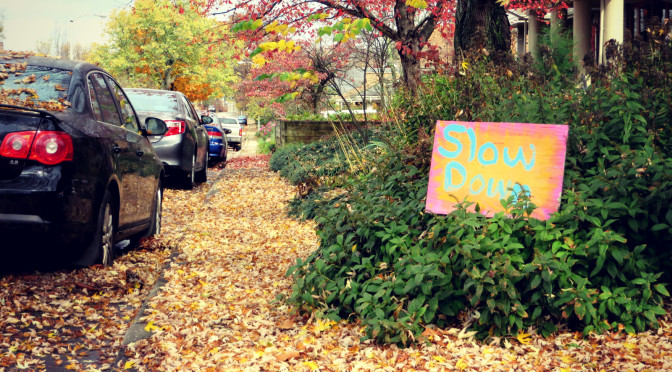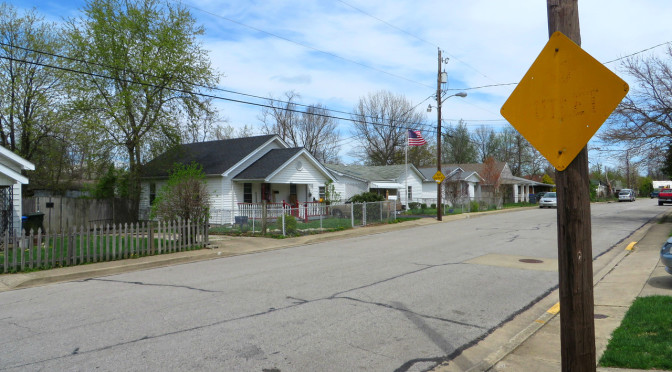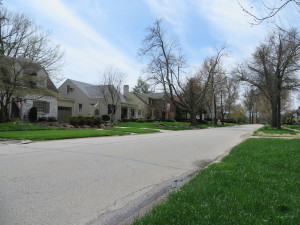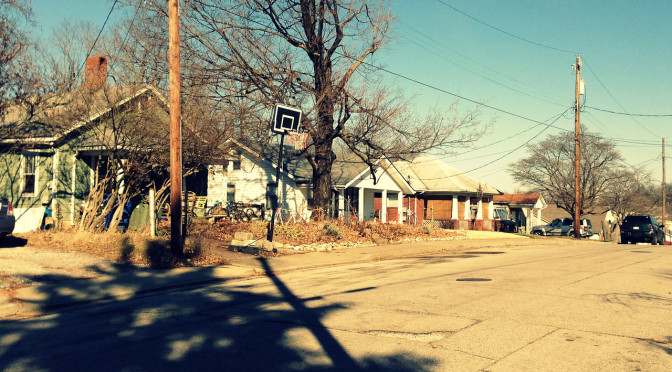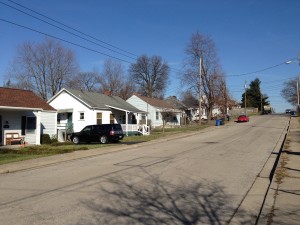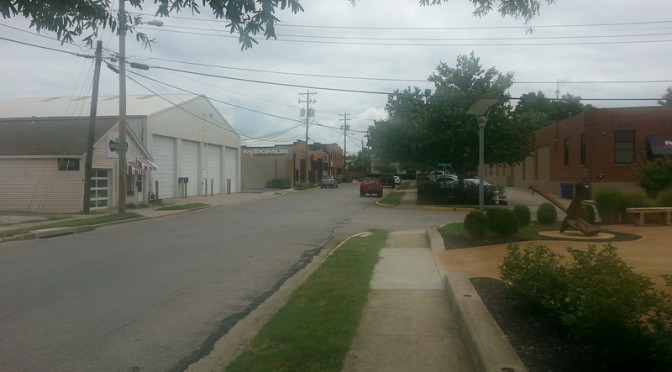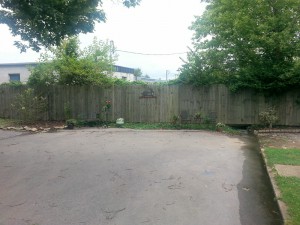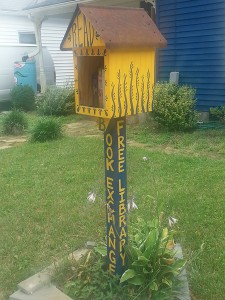Today’s walk was in Kenwick, not far from yesterday’s route in the Fairway neighborhood. Heavy rain dampened the leaves and made for a very different walk despite the still-pleasant weather. Handmade signs asking drivers to slow down are common in front of houses here. There are no tree lawns and yards generally feel a little less grand. Mentelle Park offers some common space, the only such space on this route.
Tag Archives: Kenwick
Day 96-Good bones but not a lot of meat
[load]
This route took me back to Kenwick, this time walking lengthwise, parallel to Richmond Road, on Menifee and Monroe Avenues. In terms of typology, there’s not a lot to add. These houses are similar to those in the same areas of my previous walk down Sherman and Bassett on Day 76. The houses on the north end of the area I passed through, on Owsley and Marne, tend to be older–1920’s era, then the late 1930’s and 1940’s houses on Sherman but are similar in other ways, rounding out the diversity in housing stock that I proposed made this neighborhood so economically diverse.I like Kenwick. It’s probably my favorite neighborhood so far. Its relatively regular street network contributes to walkability and its diversity without a lot of obvious tension is unique. Neighborhoods like Kenwick provide insights that planners and developers should take into account in planning future neighborhoods. But it has its problems which should also be addressed. Block length is one. The blocks heading northeast and southwest are long–close to a quarter mile. The northwest/southeast blocks are very short, around 350 feet long. The short blocks are dominated by the sides of houses that front the longer blocks which tends to make these blocks feel more desolate. There also aren’t many destinations that are truly within walking distance. National Avenue is close but still well over half a mile from the average home in the areas I passed by. The shops in the neighborhood are small and their location within the neighborhood rather than at the interface between neighborhoods probably limits their ability to serve as more than a convenience store. And even though there is a community center with a small park, it feels like there aren’t a lot of other public spaces. The net result is to delegate walking to recreational uses, even here.
Day 76-The Third Block
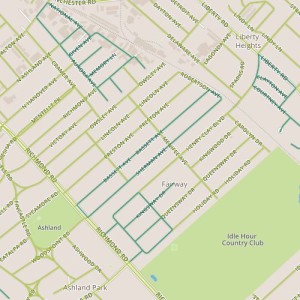 My last walk in 2014 passed through the Kenwick neighborhood , northeast of Richmond Road. This was an exciting walk for me for a couple of reasons. It’s my first good opportunity to test out a method of covering streets in which I will walk along a set of parallel streets on one day and then cover the intersecting streets at later date. (There aren’t a lot of areas that have a good string of parallel streets.) On a personal level, this was neat because it took me past a house that looked at and that was at one time high on our list of potential homes.
My last walk in 2014 passed through the Kenwick neighborhood , northeast of Richmond Road. This was an exciting walk for me for a couple of reasons. It’s my first good opportunity to test out a method of covering streets in which I will walk along a set of parallel streets on one day and then cover the intersecting streets at later date. (There aren’t a lot of areas that have a good string of parallel streets.) On a personal level, this was neat because it took me past a house that looked at and that was at one time high on our list of potential homes.
When we were looking at houses, I remember being told multiple times that this was a neighborhood in transition. Look for a house in the first couple of blocks, closer to Richmond road. That third block, we were told, was a little rougher. The character definitely changes as you progress northeast from Richmond toward Robertson and the RJ Corman tracks behind the neighborhood. The contrast between the first block of Bassett and the third block of Sherman is especially clear. The houses on the southwest end of each street typically date from the 1920’s or early 30’s. The houses on the northeast are smaller, and generally seem to have been built in the late 1930’s. Especially on Sherman, there seems to be a lot of infill, with many houses clearly newer than the 1930’s or 40’s. There is a lot going on–not only new construction but also remodeling. It may be a neighborhood in transition, but it doesn’t have the degree of tension that I found nearby on Day 17. I think diversity may have been built in with the variance in housing stock and, since it’s always been there, it’s less of a concern. It’s perhaps more a lucky accident of timing than anything else, as the Depression certainly had an impact on how these blocks developed.
Day 17
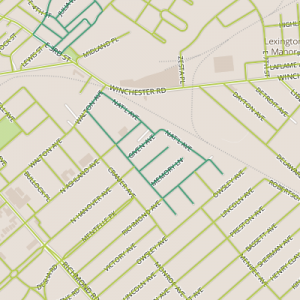 I really wasn’t sure what to expect from
I really wasn’t sure what to expect from
today’s route, through the Kenwick neighborhood, but it turned out to have a little bit of everything. I still compare things to Denver, and this neighborhood went quickly between warehouse district to streetcar suburb. I started out on Aurora, headed northwest toward Walton and found a neighborhood that felt like home to a significant creative population. These things are evidenced by things like the landscaped vegetable garden on Aurora, or the book exchange “birdhouse” on Richmond. This blended naturally into the commercial districts along Walton, National and Ashland, with it’s high concentration of home design shops and local shops—places like Kentucky Mudworks. As I walked back down National, the mix became more industrial and eventually turned to utter ruins at White Street. This is a neighborhood that seems comfortable with the industrial presence.
One street that dead-ends into the back of an industrial block has turned that end into an outdoor plaza, making it an idyllic setting despite the industrial whine and occasional sawing noise. And they also seem at home with their neighbors. I spotted no fewer than three front yard hammocks, and one yard had an entire backyard’s worth of kid toys, complete with sandpit. One gentleman I passed was working on his crossword puzzle while sitting on a collapsible lawn chair in the front yard. All of this was refreshing…this neighborhood very much answers my question about what to do about worthless grass front lawns in suburbia, alas generally in ways that aren’t covenant friendly.
Despite the comfort and overall amiability, there feels like some tension. Some homes clash, with for example, loud threats of physical violence to trespassers. These places were amazingly jarring to me, especially among very little other evidence at the time that the neighborhood was dangerous (which is borne out by crime statistics, I might add)
What works: This is a live/work dream, for those who could pull it off. Front yards are focal points.
What doesn’t: There is tension. Why?
